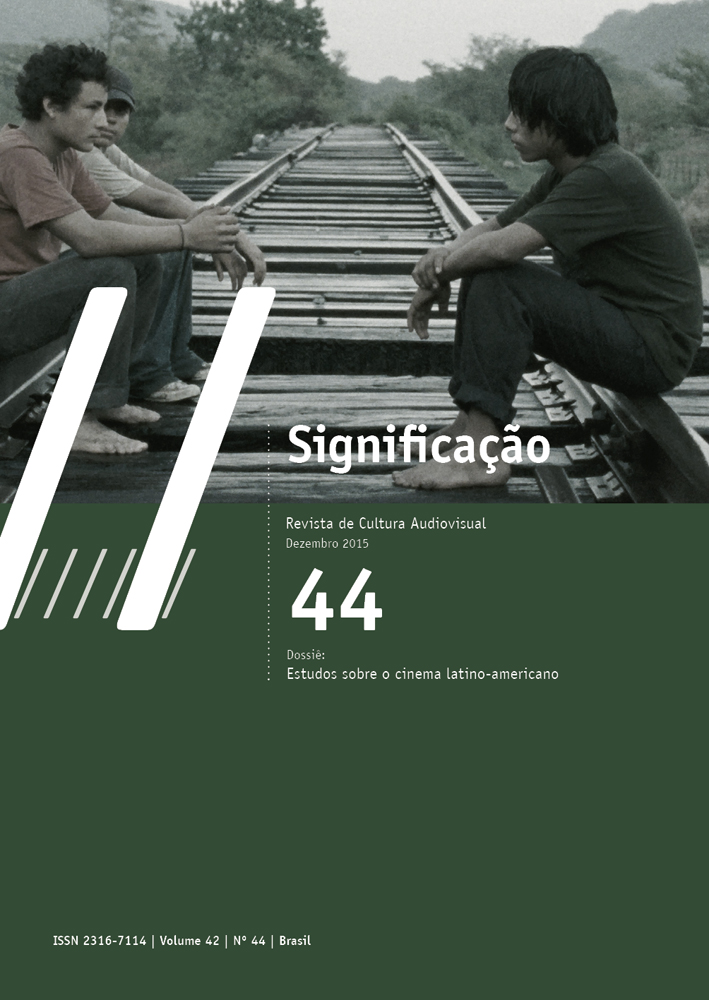An responsible eye to the pain of others: images of violence in two films of Ukamau Group
DOI:
https://doi.org/10.11606/issn.2316-7114.sig.2015.103790Keywords:
Ukamau Group, revolution, violence, politicsAbstract
The revelation of the different expressions of political violence —institutional, economic, social and symbolic–, and the problematization
the use of force "from below" towards a revolutionary change,
have been recurring topics in production of Jorge Sanjinés
the Ukamau Group (GU). This paper analyzes in two of his films,
Revolution (Jorge Sanjinés, 1963) and Blood of the Condor
(Jorge Sanjinés, 1969 ), treatment of representation and modalities
of reporting and challenge the hegemonic order. This work analyzes
in two of his films, Revolution (Jorge Sanjinés, 1963) and
Blood of the Condor (Jorge Sanjinés, 1969), the treatment of his
representation and the modalities of complaint and appeal of the
hegemonic order. Both productions put in crisis forms and stories of
History and replenish unsaid–not views of violence against bodies and
cultural identities of indigenous and popular sectors.
Downloads
References
AIMARETTI, M. Producción estética, intervención social y simbolización de la memoria cultural en Bolivia: Grupo Ukamau y Teatro de los Andes. Experiencias de una tendencia de producción cultural de horizonte político. Tesis doctoral inédita. Universidad de Buenos Aires, Facultad de Filosofía y Letras. Buenos Aires, 2014.
BÁRCENA, F. y MELICH, J.-C. “La mirada excéntrica. Una educación desde la mirada de la víctima”. En Mardones, José y Reyes Mate (eds.) La ética ante las víctimas. Madrid: Anthropos, 2003, p. 195-218.
BENJAMÍN, W. “Tesis sobre el concepto de la historia”. En Discursos interrumpidos I. Madrid: Taurus, 1994, p. 175-199.
BUTLER, J. Vida precaria. El poder del duelo y la violencia. Buenos Aires: Paidós, 2006.
CALVEIRO, P. “La memoria en tanto espacio ético y político”. En Topografías conflictivas: memorias, espacios y ciudad en disputa. Buenos Aires: Nueva Trilce, 2012, p. 21-30.
DAICICH, O. Apuntes sobre el nuevo cine latinoamericano. La Habana: EICT S.A., 2004, p. 95-115
FRÍAS, I. L. “Jorge Sanjinés”. En Los años de la conmoción. México: 1979, p. 79-92.
GARCÍA PABÓN, L. “A propósito de la Nación Clandestina”. En El cine de Jorge Sanjinés. Santa Cruz: Primer Festival de Cine Iberoamericano de Santa Cruz de la Sierra, 1999, p. 90-107.
GUMUCIO DAGRON, A. Historia del cine boliviano. La Paz: Los amigos del libro, 1982.
________. Cine, censura y exilio en América Latina. México: STUNAM, CIMCA y Federación Editorial Mexicana, 1982b.
HUBERMAN, G. D. Pueblos expuestos, pueblos figurantes. Buenos Aires, Manantial: 2014.
MESA, C. “Intento de aproximación al cine boliviano”. En Mesa, C. (coord.) Cine boliviano, del realizador al crítico. La Paz: Gisbert, 1979, p. 13-65.
________. La aventura del cine boliviano. La Paz: Gisbert, 1985.
SANJINÉS, J. “Caminos del Grupo Ukamau”. En Revista Octubre Nº 5 Enero. México, 1979, p. 10-20
________.“Ukamau y Yawar Mallku. Entrevista a Jorge Sanjinés. Revista Afterimage Nº 3 Verano 1971. Londres”. En Carlos Mesa (coord.) Cine Boliviano: del realizador al crítico. La Paz: Editorial Gisbert, 1979b, p. 135-153
________. “Nuestro propósito: hacer un cine útil para el pueblo. Conferencia con motivo de la presentación de “Yawar Mallku”, Ecuador, 1976” reproducida en Teoría y práctica de un cine junto al pueblo. México: Siglo XXI, 1980, p. 91-99.
________. “Sobre el cortometraje” en El cine de Jorge Sanjinés. Santa Cruz, FEDAM y Festival Iberoamericano de Cine de Santa Cruz, 1999, p. 28-33.
RUSSO, S. “Yawar Mallku”. En AA.VV. Cuadernos de Cine Latinoamericano. Jorge Sanjinés y el Grupo Ukamau. Reflexiones y testimonios. Buenos Aires: Tierra del Sur, 2010, p. 127-130
STEGMAYER, M. y CUESTA, M. “Descentramientos contemporáneos de la memoria. Algunos interrogantes”. Ponencia en Actas Digitales del V SEMINARIO INTERNACIONAL POLÍTICAS DE LA MEMORIA “Arte y Memoria. Miradas sobre el pasado reciente” organizado por Secretaría de Derechos Humanos, Ministerio de Justicia y Derechos Humanos de la Presidencia de la Nación Argentina, Archivo Nacional de la Memoria y Centro Cultural de la Memoria Haroldo Conti, 4, 5 y 6 de octubre de 2012.
TERÁN, O. Nuestros años sesentas. Buenos Aires: Puntosur, 1991.
VERGARA, X. “Fertilizar la memoria, reconstruir la masacre: teorías y prácticas en el cine de Jorge Sanjinés” en Wolkgang Bongers (ed.) Prismas del cine latinoamericano. Chile: Cuarto Propio, 2012, p. 167-190
Downloads
Published
Issue
Section
License
Copyright (c) 2015 María Gabriela Aimaretti

This work is licensed under a Creative Commons Attribution-NonCommercial 4.0 International License.
Authors who publish in this journal must agree with the following terms:
- Authors keep their copyrights and grant the journal first time publication rights, having their articles simultaneously licensed under the Creative Commons Attribution License, which allows sharing texts with authorship recognition and first publication on this journal for non-commercial purposes.
- Authors are allowed to make additional contracts, for a non-exclusive distribution of the article’s version published on this journal (e.g.: publishing in institutional repositories of articles or as a book chapter), with authorship recognition and first publication on this journal.
















